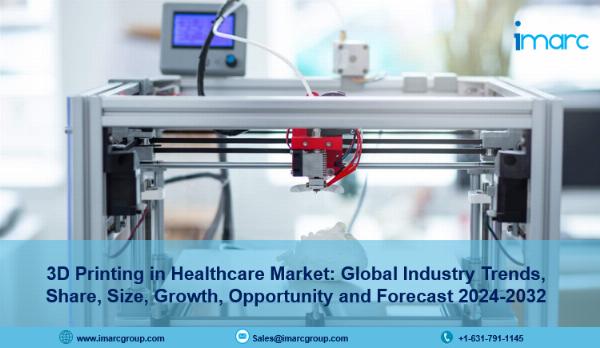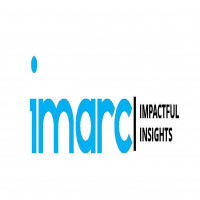IMARC Group's report titled "3D Printing in Healthcare Market Report by Material (Polymer, Metals, Ceramic, Organic), Technology (Droplet Deposition, Photopolymerization, Laser Beam Melting, Electronic Beam Melting (EBM), Laminated Object Manufacturing, and Others), Application (External Wearable Devices, Clinical Study Devices, Implants, Tissue Engineering), End User (Medical and Surgical Centers, Pharmaceutical and Biotechnology Companies, Academic Institutions), and Region 2024-2032". offers a comprehensive analysis of the industry, which comprises insights on the global 3d printing in healthcare market report. The global market size reached US$ 3.0 Billion in 2023. Looking forward, IMARC Group expects the market to reach US$ 9.4 Billion by 2032, exhibiting a growth rate (CAGR) of 13.2% during 2024-2032.
Grab a sample PDF of this report: https://www.imarcgroup.com/3d-printing-in-healthcare-market/requestsample
Factors Affecting the Growth of the 3D Printing in Healthcare Industry:
Customization and Personalization:
3D printing allows for the creation of patient-specific implants, prosthetics, and orthopedic devices. By tailoring these products as per the anatomy of patients, it ensures a perfect fit, improving comfort and functionality. In addition, personalized medical devices reduce the risk of complications and improve patient outcomes. Patients experience better mobility and comfort, leading to improved quality of life. Moreover, 3D printing enables the fabrication of customized dental implants, crowns, and orthodontic devices. This precision ensures better aesthetics and functionality for patients.
Cost-Efficiency:
3D printing technology minimizes the need for traditional manufacturing processes, such as casting or machining. This leads to lower production costs for medical devices, implants, and prosthetics. 3D printers can use materials efficiently, resulting in less waste during the manufacturing process. This cost-saving aspect is particularly important when working with expensive or rare materials. Additionally, traditional manufacturing methods often require costly customization for individual patients. With 3D printing, customization can be achieved without significantly increasing production expenses.
Rapid Prototyping:
3D printing allows for the rapid creation of prototypes and iterations of medical devices, implants, and equipment. This speed expedites the product development process, reducing time-to-market. In addition, healthcare professionals and engineers can quickly test and refine their designs through iterative prototyping. This helps identify and rectify design flaws, improving the safety and effectiveness of medical solutions. Besides this, rapid prototyping enables the creation of patient-specific prototypes. Healthcare providers can develop personalized devices and implants for individual patients, enhancing their overall care and outcomes.
Leading Companies Operating in the Global 3D Printing in Healthcare Industry:
3D Systems Inc.
Desktop Metal Inc.
EOS GmbH
Formlabs
Materialise NV
Organovo Holding Inc.
Oxford Performance Materials Inc.
Prodways Tech
Proto Labs Inc.
Renishaw plc
SLM Solutions Group AG
Stratasys Ltd
3D Printing in Healthcare Market Report Segmentation:
By Material:
Polymer
Metals
Ceramic
Organic
Polymer represents the largest segment due to its versatility, cost-effectiveness, and suitability for a wide range of medical applications, including prosthetics and orthopedic implants.
By Technology:
Droplet Deposition
Fused Filament Fabrication (FFF) Technology
Low-temperature Deposition Manufacturing (LDM)
Multiphase Jet Solidification (MJS)
Photopolymerization
Stereolithography (SLA)
Continuous Liquid Interface Production (CLIP)
Two-photon Polymerization (2PP)
Laser Beam Melting
Selective Laser Sintering (SLS)
Selective Laser Melting (SLM)
Direct Metal Laser Sintering (DMLS)
Electronic Beam Melting (EBM)
Laminated Object Manufacturing
Others
Droplet deposition accounts for the majority of the market share as it offers high precision and the ability to create complex, patient-specific structures, making it ideal for producing medical devices and implants.
By Application:
External Wearable Devices
Hearing Aids
Prosthesis and Orthotics
Dental Products
Clinical Study Devices
Drug Testing
Anatomical Models
Implants
Surgical Guides
Cranio-maxillofacial Implants
Orthopedic Implants
Tissue Engineering
External wearable devices exhibit a clear dominance in the market owing to the growing demand for personalized, non-invasive healthcare solutions like custom-fitted hearing aids and smart wearables.
By End User:
Medical and Surgical Centers
Pharmaceutical and Biotechnology Companies
Academic Institutions
Medical and surgical centers hold the biggest market share, driven by the adoption of 3D printing for creating patient-specific implants, surgical guides, and prosthetics, enhancing patient care and surgical outcomes.
Regional Insights:
North America (United States, Canada)
Asia Pacific (China, Japan, India, South Korea, Australia, Indonesia, Others)
Europe (Germany, France, United Kingdom, Italy, Spain, Russia, Others)
Latin America (Brazil, Mexico, Others)
Middle East and Africa
North America enjoys the leading position in the 3D printing in healthcare market on account of a strong healthcare infrastructure, research and development (R&D) activities, and a growing demand for customized medical solutions in the region.
Global 3D Printing in Healthcare Market Trends:
Bioprinting, which involves the 3D printing of living tissues and organs, is advancing rapidly, enhancing organ transplantation and tissue engineering.
Governments and regulatory bodies are developing specific guidelines and standards for 3D-printed medical devices and implants to ensure safety and quality.
Note: If you need specific information that is not currently within the scope of the report, we will provide it to you as a part of the customization.
About Us:
IMARC Group is a leading market research company that offers management strategy and market research worldwide. We partner with clients in all sectors and regions to identify their highest-value opportunities, address their most critical challenges, and transform their businesses.
IMARCs information products include major market, scientific, economic and technological developments for business leaders in pharmaceutical, industrial, and high technology organizations. Market forecasts and industry analysis for biotechnology, advanced materials, pharmaceuticals, food and beverage, travel and tourism, nanotechnology and novel processing methods are at the top of the company’s expertise.
Our offerings include comprehensive market intelligence in the form of research reports, production cost reports, feasibility studies, and consulting services. Our team, which includes experienced researchers and analysts from various industries, is dedicated to providing high-quality data and insights to our clientele, ranging from small and medium businesses to Fortune 1000 corporations.
Contact US:
IMARC Group
134 N 4th St. Brooklyn, NY 11249, USA
Tel No:(D) +91 120 433 0800
United States: +1-631-791-1145 | United Kingdom: +44-753-713-2163



